Springtime in Arcadia: What to See, Do and...
Just a short distance from Athens,...

While at first sight a normal fishing village, Katakolo is the 5th most important port for cruise ships in Greece thanks to the draw of Ancient Olympia.
© Nikos Kokkas
“Supposedly, today we were to have four boats, that is eight to ten thousand visitors. Where are they?” I have no idea, nor answer for the waiter who is waiting for the passengers of the cruise ships that dock in Katakolo to inundate Ancient Olympia and his establishment. While disappointed by the empty tables, he does not lose his good spirits; he takes our order and then that of an Italian couple, and life goes on.
Built below Kronos Hill, in the valley formed by the Alfeios River, Ancient Olympia is a small settlement a stone’s throw from the archaeological site. Its tourism strategy is simple, single-mindedly focused on a classic Greek aesthetic. Postcards, fridge magnets, statuettes, hats, bags, sunglasses – the items on sale at the tourist shops here are just like those in Athens’ Monastiraki and Plaka districts.

The dam on the Alfeios River.
© Nikos Kokkas

Klia introduces visitors to her farm to the fascinating world of beekeeping.
© Nikos Kokkas
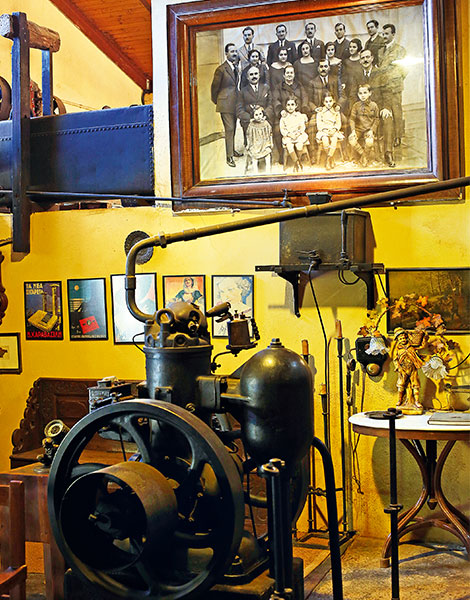
The visitable Mercouri Estate, with its small museum, has long been the flag-bearer for wine producing in Ilia.
© Nikos Kokkas
And yet, there are also representatives of a more modern and innovative approach to tourism, they are just not immediately apparent. Tripadvisor’s top suggestion on the list of activities in the entire region of Ilia is Klio’s Honey Farm: 97% of the 194 traveller reviews on the site give it 5 out of 5 stars. An exceptional rating, fitting for a person as exceptional as Klio.
A beekeeper and the owner of a visitable farm a short way from Olympia, she welcomes visitors with a quince spoon sweet, crunchy honeyed diples (made from thin, fried dough) and coffee, and then gives them a short lesson in beekeeping. She starts off with simple information and then moves on to more specialist knowledge.
“The queen bee fertilizes the eggs that will become females and leaves unfertilized the one’s destined to be males.” What does that mean? “That the drones have no father”. The family sitting next to us laughs at this piece of information. It comprises two teenaged boys with their father, who, at the end of the lesson, put on beekeepers’ masks, and pose for pictures with pieces of honeycomb. It’s this that makes the farm so successful. Visitors don’t just see an attractive estate, but they learn and enjoy themselves.
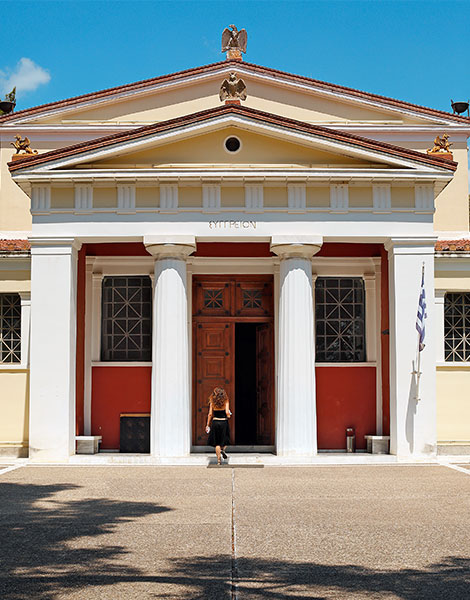
The Museum of the History of the Ancient Olympic Games
© Nikos Kokkas

At the archaeological site of Olympia, the main tourist draw in Ilia, adults rediscover their inner child.
© Nikos Kokkas
Full of pines, olive trees, oleander and the hum of cicadas, the archaeological site of Olympia is busy from early in the morning. French children in broad hats like 19th century archaeologists describe to their parents the partial restoration of the circular Philippeion monument, reading aloud from the guidebook that they have conscientiously brought along with them. In contrast, a group of less well-prepared Italians, without guidebooks and only a smattering of English, struggle to read the explanatory note at the pedestals of the Zanes (the copper statues of Zeus that were commissioned using the fines collected from athletes who violated the rules of the Olympic Games). A group of Asian women gaze with awe at the reproduction of the monuments of Ptolemy II and Arsinoe II in front the of Echo Stoa. And, without exaggeration, at least half of the visitors to the Stadium, irrespective of ethnicity, pose for pictures crouching at the starting line.
Beyond its transfixing beauty and tremendous educational and cultural value, the archaeological site of Olympia is also a very lively place. Children act as adults and adults like children. The young ones study intently Wikipedia articles about the Bouleuterion (the assembly house of the local legislature) and the villa of the Roman emperor Nero, while their parents bend over and pretend to pick up an ancient column.
The same atmosphere is to be found in the museums, the Archaeological Museum and the Museum of the History of the Ancient Olympic Games (one ticket costing 12 euros grants access to both museums and the archaeological site). Visitors admire the perfect body of Hermes created by the renowned master sculptor Praxiteles (340-333 BC, found in 1877 in the in temple dedicated to Hera) who is holding the infant Dionysus with a mixture of wonder and easy familiarity. It’s a similar scene at the (incredible) sculptural composition of the west pediment of the Temple of Zeus which depicts the battle between the Lapiths and the Centaurs.
The art of ancient Greece has such a wide appeal, has influenced Western (and not only) civilization to such a degree, that it operates as a shared point of reference for people from completely different backgrounds. That’s why leaving the archaeological site of Olympia you feel an unexpected sense of optimism. Because you have just shared an experience in a common tongue with hundreds of unknown strangers without even speaking to them.

Beach fun in Gianitsohori.
© Nikos Kokkas
Beyond being a cradle of civilization and source of optimism, Ancient Olympia is one of the two main tourism draws in Ilia. The second is Katakolo, the fifth most important port for cruise ships in the country, after those of Piraeus, Mykonos, Corfu and Santorini. In 2017 it received 567,000 cruise ship passengers (i.e. more that Rhodes and Irakleio combined).
And yet, seeing it up close, one is surprised because it is nothing more than a small village, simple and picturesque, with fishing boats contrasting absurdly with the vast hull of the Holland America Line which is moored opposite them. Tour guides crowd around the port holding signs with American and British flags, advertising their services to the disembarking tourists. The colorful buildings along the waterfront give Katakolo an appearance more in line with the Ionian islands, as opposed to the Peloponnese.

An exhibit at the Museum of Ancient Greek Technology.
© Nikos Kokkas
While small, Katakolo has several notable points of interest, such as the Museum of Ancient Greek Technology which presents replicas of ancient Greek inventions: the Pythagoraean cup (a vessel which, if filled beyond a line, would empty out all its contents), the mechanical paradox of Archimedes (which gives the illusion that an object is rolling uphill) and the “smart” wine decanter of Philonos of Byzantium which would pour wine, water, or a wine and water mixture depending on what the pourer wanted.
Another standout is Kukuvaya, a shop dedicated to the modern Greek souvenir, with creations by Greek designers that draw inspiration from history, gastronomy and daily life (an ouzo bottle that resembles a Greek tsolias – a traditionally dressed soldier, mugs with sayings by Aristotle and Socrates, etc.).
Nearby is a lighthouse that was constructed in 1865 and which has been declared a historic monument, while in the neighboring village of Korakohori the visitable Mercouri Estate operates, which is 140 years old and is a key force in the wine industry of Ilia. “You are a family of poets,” we read in the guestbook, one of many warm notes left by travelers that make plain how much this estate is loved by oenophiles.
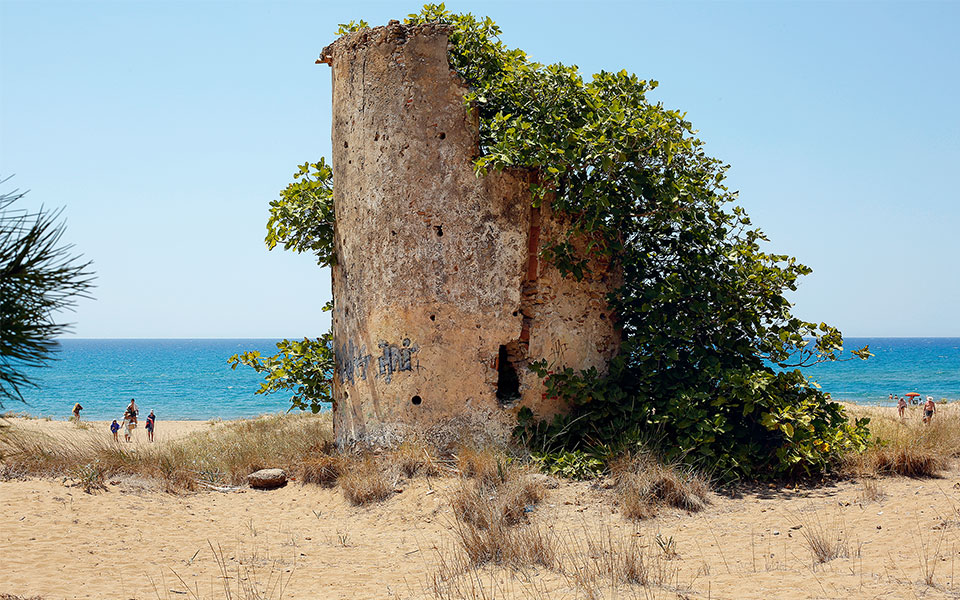
A ruin on Kaifas Beach on the Ionian which is just across the road from the lake of the same name.
© Nikos Kokkas

The Kaiafas thermal baths are just across the road from the beach.
© Nikos Kokkas
South of Katakolo, in the middle of the Bay of Kyparissia, is renowned Kaiafas Lake, said to be named after Caiaphas, the leader of the Jewish elders who condemned Jesus Christ. There are various versions of how its name came about. The most famous is that after Jesus’ crucifixion Caiaphas traveled towards Rome, but his ship encountered a storm forcing it to shelter on the Peloponnesian coast. He went to bathe in the thermal spring, but he was so corrupted as an individual that the waters became foul and malodorous. Usually in folk traditions water represents a cleansing force, but the specific legend breaks this rule, proving how great Caiaphas’ sin was in the collective consciousness – a man who not only could not clean himself, but poisoned the water itself.
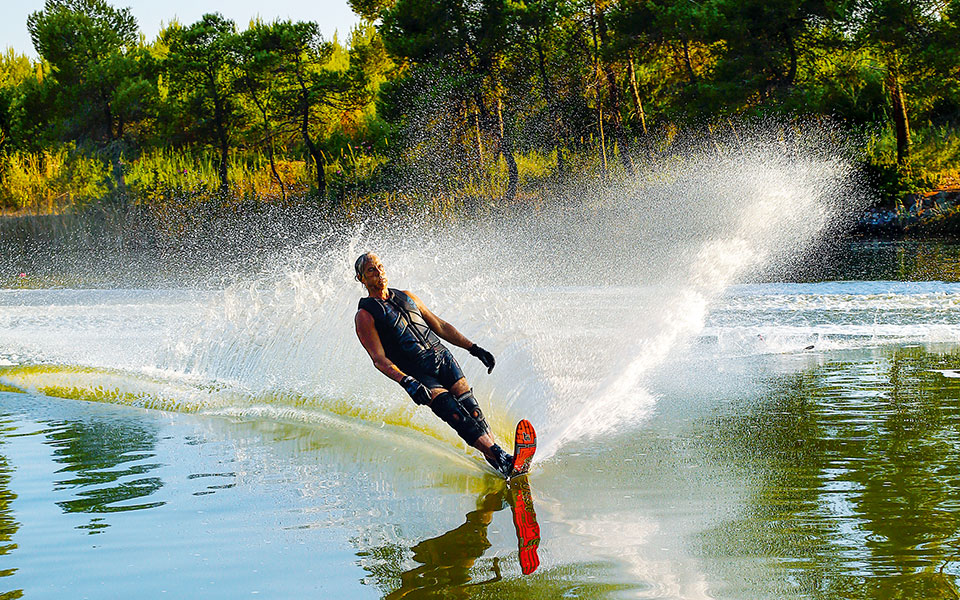
Waterskiing on Lake Kaifa
© Nikos Kokkas
Indeed the water at the thermal baths have a heavy odor, as do most hot springs where the waters contain sulfur. “But they are beneficial for musculoskeletal problems such as arthritis, rheumatism, discopathy, sciatica and neck pain. And for skin conditions,” we are told by an attendant at the baths. And they are becoming ever more popular. On the day that we visit we do not only see elderly people seeking respite from their ailments, but young people swimming for pleasure. The waters are between 33-34° C and the recommended duration of a dip is between 20-30 minutes (those with health conditions should consult their doctor beforehand).
In front of the hydrotherapy facility is Lake Kaiafa with its small island of Aghia Aikaterini, which attracts water skiers thanks to its flat waters. On the island the renovated (and recommended) Olympia Hotel operates.
Unfortunately however, elsewhere on the island the picture is not great. The remaining facilities that belong to the Greek Tourism Organization (EOT) have been completely abandoned: a series of derelict hotels with cracked windows and half-open doors. It gives the impression that there has been a huge brawl and the quarreling parties left without cleaning up the mess. That’s what you feel walking along Aghia Aikaterini.

A screening at the open air cinema Cine Rodon.
© Nikos Kokkas
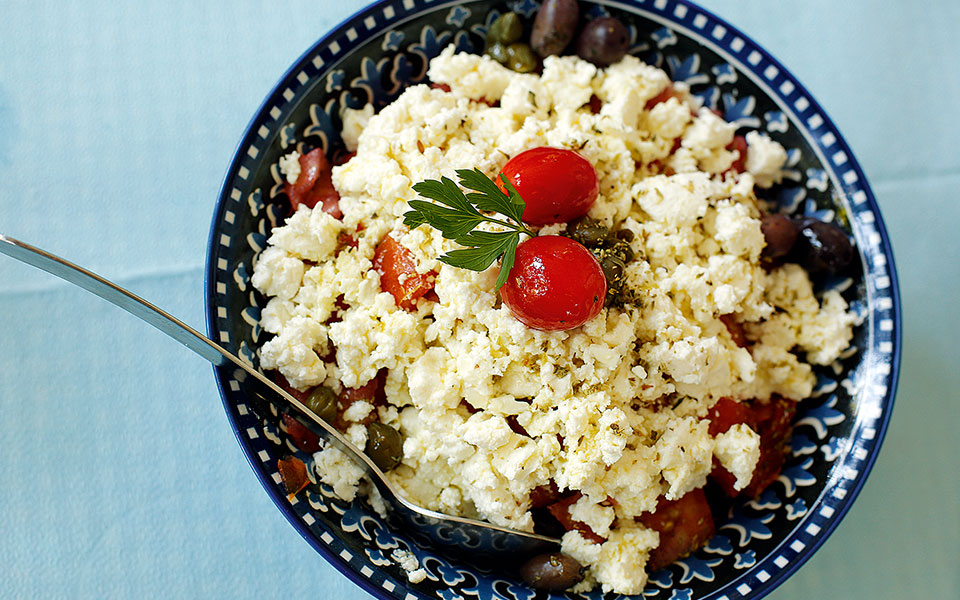
You will enjoy greek dishes made with local ingredients at Kati Psenetai in Kakovato.
© Nikos Kokkas
This is not the only time that we encounter ugly sights in Ilia. The Bay of Kyparissia, lined by an enormous, 46 km stretch of sand, is full of illegal settlements. A case in point is that of Spiantza: illegal buildings with tin roofs and laundry hanging outside are built right up to the water’s edge. There are countless such illegal buildings which, aside from being ugly, also harm the area’s sensitive ecosystem.
Thankfully, in between the illegal settlements there are plenty “free zones” which belong to the swimmers and the Caretta caretta turtles that nest on the beach. Here one can enjoy the sea, sand and sunset, where the yellow sun sinks beneath the clouds, and, turning orange, and then red, slowly sinks into the sea leaving a horizon stained purple. The sunset in Ilia is truly one of a kind.
Our final stop is Stafidokampos, a small village near Andravida. Here one finds the Cine Rodon, a municipal outdoor cinema so well cared for that you feel as if you are in 1950s America, at a time when people looked forward to going to the movie theater all week. It has a lawn, red director’s chairs and a huge screen, “12 meters in height and 18 meters in width,” we are told by Giorgos Alevizopoulos. He is the president of the Cultural-Artistic Center of Stafidokampos and the soul of Cine Rodon, the person who appears to be loved and respected by all of the group’s members for the know-how and effort he has contributed. Cine Rodon attracts moviegoers from all around the western Peloponnese. Indeed in 2010 it broke new ground by hosting the first 3D screening at an outdoor cinema in Greece. Kudos Cine Rodon!
Getting There
Ancient Olympia is approximately 290 km from Athens. The estimated cost for gas and tolls (one way) is 45 euros.
Where to Stay
Orizontes View Hotel is a pretty and modern hotel in Katakolo (tel. +30 26210-41781, orizonteshotel.gr), which also has a cafe that offers a panoramic view of the port and the anchored cruise ships. 88 euros for a double.
An option that stands out from the rest is the hotel Olympia (tel. +30 26250-31705, open until 15/11) on the small island of Aghia Aikaterini in Kaiafas Lake. It has been recently renovated, has friendly staff and is located in a prime location. 55 euros for a double.
Where to Eat
The taverna Symposio (tel. +30 26240-23620) in Ancient Olympia serves classic Greek dishes such as moussaka and stuffed vegetables. At Antipeina (tel. +30 26250-33035) in the village of Schinoi try the boiled zucchini with garlic and oil, and kagiana (egg and tomato scramble) with cured pork. At Kati Psenetai in Kakovato (tel. +30 26250-32147) you will enjoy sea food and local meats cooked on the grill.
For refreshing cocktails seek out the beach bar Casablanca in Zaharo.
Just a short distance from Athens,...
Greece Is presents "Peloponnese Trails," a...
In Leonidio, Easter comes alive with...
Discover five mountain destinations where crisp...